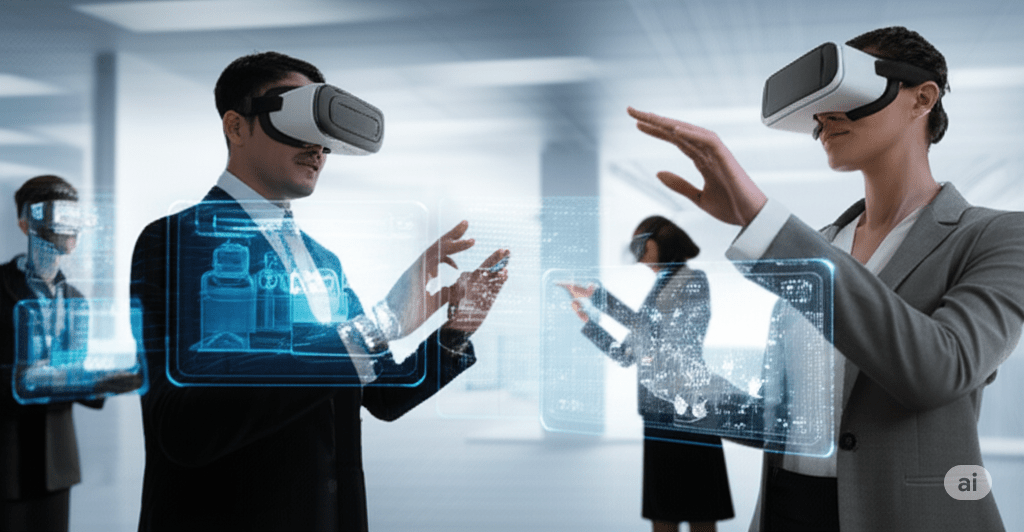Imagine a world where learning isn’t confined to textbooks or static online modules. Picture stepping into a realistic, interactive environment where you can practice complex procedures, collaborate with colleagues across the globe, and receive personalized feedback in real-time. This isn’t science fiction; it’s the burgeoning reality of professional training powered by the convergence of Artificial Intelligence (AI) and the metaverse, often experienced through Virtual Reality (VR). While VR has long promised immersive learning, the integration of AI metaverse training is unlocking unprecedented levels of engagement, personalization, and effectiveness, transforming how organizations develop their talent.
For years, businesses have sought more impactful and cost-effective ways to train their workforce. Traditional methods often fall short, struggling with learner engagement, knowledge retention, and the ability to provide practical, hands-on experience, especially for complex or high-risk tasks. This is where the synergistic power of AI and the metaverse comes into play. By creating dynamic, intelligent virtual environments, AI metaverse training offers a learning experience that is not only engaging but also deeply tailored to the individual needs of each learner, paving the way for a more skilled and confident workforce.
AI in Cloud Security: Protecting Your Digital Assets in the Cloud Era
The Transformative Power of AI in Virtual Learning Environments
The metaverse, a network of interconnected virtual worlds, provides the immersive stage for training. However, it’s AI that breathes intelligence and adaptability into these digital realms. AI algorithms enhance AI metaverse training in numerous ways, creating a far more dynamic and effective learning experience than standalone VR applications.
Intelligent Personalization: Tailoring Learning Journeys
One of the most significant contributions of AI is its ability to personalize the learning experience. By tracking a trainee’s progress, identifying their strengths and weaknesses, and analyzing their interaction patterns within the virtual environment, AI algorithms can adapt the training in real-time. This means that learners who grasp concepts quickly can move ahead, while those who need more support receive targeted guidance and additional practice in specific areas. This level of individualization, often challenging to achieve in traditional group training settings, ensures that every learner gets the support they need to master the required skills through AI metaverse training.
Your Ultimate Guide to AI Network Security: Protecting Your Business from Modern Cyber Attacks
Realistic Simulations with Intelligent Feedback
AI powers more realistic and responsive simulations within the metaverse. For example, in a virtual environment designed for training medical professionals, AI can control virtual patients who exhibit symptoms and respond to treatments in a nuanced and unpredictable manner. Furthermore, AI can provide immediate and detailed feedback on a trainee’s actions, highlighting areas for improvement and reinforcing correct procedures. This instant feedback loop accelerates learning and helps solidify skills in a safe and controlled environment offered by AI metaverse training.
Enhanced Collaboration and Communication
AI can facilitate more effective collaboration within metaverse training environments. Intelligent virtual avatars, powered by natural language processing, can understand and respond to trainees’ verbal and non-verbal cues, creating a more natural and engaging collaborative experience. AI can also analyze team dynamics and provide insights on how to improve communication and teamwork within virtual training scenarios, a key benefit of AI metaverse training.
Data-Driven Insights for Training Optimization
The integration of AI into metaverse training provides a wealth of data on learner performance and engagement. AI algorithms can analyze this data to identify trends, pinpoint areas where trainees commonly struggle, and assess the overall effectiveness of the training program. These insights enable organizations to continuously refine their training content and delivery methods, ensuring that their AI metaverse training remains relevant and impactful over time.
Real-World Applications: AI Metaverse Training in Action
The potential of AI metaverse training is already being realized across various industries. Here are a few compelling examples:
Healthcare: Mastering Complex Procedures Safely
Medical professionals often need to learn and practice intricate surgical procedures or respond to rare medical emergencies. AI metaverse training provides a safe and realistic environment to hone these critical skills without any risk to real patients. AI-powered virtual patients can present with diverse conditions, react realistically to interventions, and provide trainees with immediate feedback on their technique. Companies like HubSpot also emphasize the importance of practice and feedback in professional development, principles perfectly embodied by AI-driven VR training.
Manufacturing: Upskilling for Automation
As manufacturing processes become increasingly automated, the need for skilled technicians who can maintain and troubleshoot complex machinery is growing. AI metaverse training allows technicians to interact with virtual replicas of equipment, diagnose problems, and practice repair procedures in a highly realistic and interactive way. AI can guide them through the steps, provide real-time feedback on their actions, and even simulate unexpected equipment failures to test their problem-solving abilities within the AI metaverse training module.
Customer Service: Enhancing Empathy and Communication
Training customer service representatives to handle difficult or sensitive interactions can be challenging. AI metaverse training offers a unique solution by creating virtual scenarios where trainees can interact with AI-powered virtual customers who exhibit a range of emotions and communication styles. AI analyzes the trainee’s responses and provides feedback on their empathy, communication skills, and ability to resolve customer issues effectively within the AI metaverse training environment.
Case Study 1: Aerospace Engineering with Immersive AI
A leading aerospace manufacturer implemented AI metaverse training for new engineers learning to assemble complex aircraft components. Using VR headsets and interacting with a virtual model of the aircraft, guided by an AI assistant that provided step-by-step instructions and real-time feedback on their assembly accuracy, the new hires achieved proficiency 40% faster than with traditional manual-based training. The AI also tracked common errors, allowing the training program to be updated with more emphasis on those specific areas.
Case Study 2: Retail Skills Development in a Virtual Store
A large retail chain utilized AI metaverse training to onboard new sales associates. They created a virtual store environment where new hires could practice interacting with AI-powered virtual customers, handling different scenarios like product inquiries, returns, and complaints. The AI provided personalized feedback on their communication style, product knowledge, and problem-solving skills, resulting in a 25% improvement in customer satisfaction scores for newly trained employees compared to those trained solely through traditional methods.
Key Tools and Platforms for AI Metaverse Training
The ecosystem for creating and deploying AI metaverse training solutions is rapidly evolving. Here are some key types of tools and platforms:
- VR Development Platforms with AI Integration: Platforms like Unity and Unreal Engine offer robust tools for creating immersive VR environments and increasingly provide APIs and integrations for incorporating AI functionalities.
- Unity Official Site: Unity
- Unreal Engine Official Site: Unreal Engine
- AI-Powered Learning Analytics Platforms: Tools that can integrate with VR training environments to track learner data, analyze performance, and provide actionable insights for training optimization. Platforms like OpenAI could potentially be leveraged for backend AI analysis.
- AI Avatar and Natural Language Processing (NLP) SDKs: Software Development Kits that allow developers to create intelligent virtual avatars that can understand and respond to natural language input, enhancing the interactivity of AI metaverse training scenarios.
- Standalone VR Training Platforms with Built-in AI Features: Some platforms are specifically designed for professional training and incorporate AI features like personalized learning paths and intelligent feedback directly into their VR environments.
Getting Started with AI-Enhanced VR Training: A Practical Approach
Implementing AI metaverse training doesn’t have to be an overwhelming undertaking. Here’s a beginner-friendly workflow:
- Identify Key Training Needs: Determine which areas of your professional training would benefit most from immersive, interactive experiences and personalized feedback. Focus on areas with high complexity, safety risks, or significant impact on performance.
- Define Clear Learning Objectives: What specific skills or knowledge do you want trainees to acquire through the AI metaverse training program? Clearly defined objectives are crucial for designing effective training content and measuring success.
- Choose the Right Platform and Tools: Research available VR development platforms and AI integration options. Consider factors like ease of use, features, cost, and scalability. Starting with a platform that offers some built-in AI capabilities can be a good entry point.
- Develop Engaging and Realistic VR Content: Work with VR developers and instructional designers to create immersive and interactive training scenarios that align with your learning objectives. Ensure that the virtual environment accurately reflects real-world situations.
- Integrate AI for Personalization and Feedback: Utilize AI tools and APIs to track learner progress, provide personalized guidance, and deliver immediate, constructive feedback within the VR training environment.
- Pilot and Iterate: Start with a small pilot program to test the effectiveness of your AI metaverse training. Gather feedback from trainees and trainers, analyze the data, and make necessary adjustments to the content and delivery.
- Scale and Expand: Once you have a successful pilot program, gradually scale your AI metaverse training initiatives to other areas of your organization, continuously monitoring and optimizing for maximum impact.
The Future of Professional Development: Immersive and Intelligent
VR professional development represents a significant leap forward in professional development. By combining the immersive power of virtual reality with the intelligence and adaptability of artificial intelligence, organizations can create learning experiences that are more engaging, effective, and personalized than ever before. As the technology continues to evolve and become more accessible, we can expect to see widespread adoption of AI metaverse training across industries, transforming the way we learn and work. Embracing this innovative approach today will not only enhance your training programs but also position your organization as a leader in the future of professional development. The potential for growth and skill enhancement through intelligent virtual environments is immense, and the journey into VR professional developmentis just beginning.



